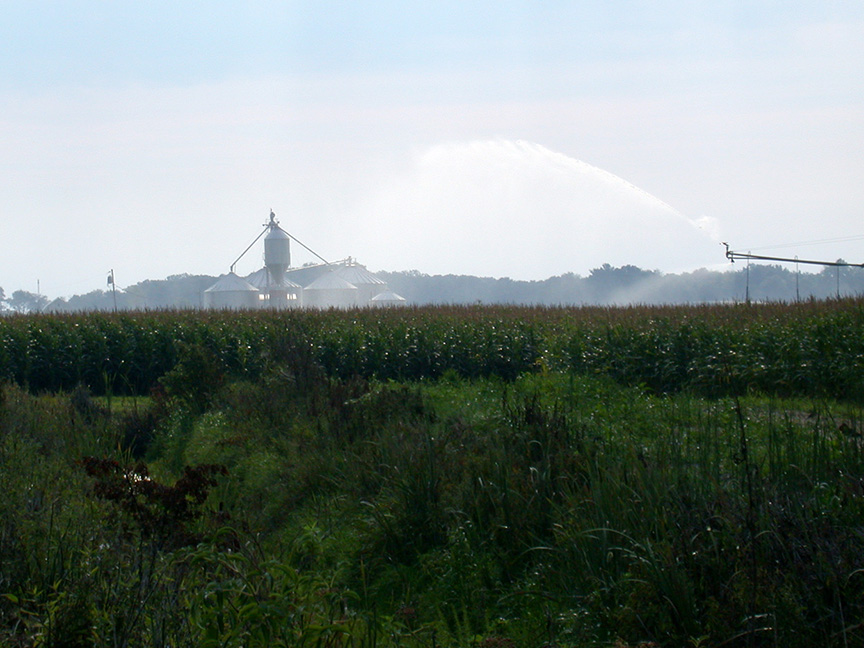Deck: Maximizing profit and returns on resources invested can be dependent on the last irrigation application.
Late August and early September often bring the question, “When can I stop irrigating?” The factors that enter into making this decision are fuel costs which have been sliding higher, and grain and forage values that have had recent lows. Turning off the irrigation water to soon could lower yields or reduce test weight. Irrigating beyond the crop’s need wastes resources: time, energy, and money.

A field of corn being irrigated.
Late August and early September weather conditions usually alleviate the late season irrigation application questions. The typical crop water use drops just as the average rainfall increases. Often, late season irrigation is not needed. However, many of the area’s late planted crops will have substantial water needs well into September, signaling the need for some type of irrigation scheduling or crop monitoring.
Late season water use, termed evapotranspiration (E.T.) lowers significantly as the plants move towards maturity. Soybean plants showing their first yellow pod will have E.T. of one tenth of an inch per day for days that highs reach into the mid 80 degree temperatures. Corn at dent stage will have an E.T. of 0.14”/day for a day that daytime highs reach the mid 80’s. Daily temperatures that are ten degrees higher or lower than the mid 80’s will have an E.T. 0.02” higher or lower than the norm, respectively.
The goal of the soybean irrigator should be to maintain at least 50% of the available soil water holding capacity for soybeans until most pods yellow. Corn producers trying to maintain test weight in dry late summer conditions should maintain at least 50% of the available soil water holding capacity until the crop reaches black layer. In most situations, minimal amounts of water are needed to achieve these goals. In the last few weeks of the season, soybeans will use less than 0.04” per day and corn less than 0.06” per day, allowing a half inch of rain or irrigation to last a week or more.
Avoid relying on what the neighboring irrigators are doing as a guide to when your crop will no longer need irrigation. The huge variability in planting dates and variety of crops irrigated can result in mature fields no longer in need of irrigation, and neighboring fields that are just entering their peak need for water. Each crop and field will differ with respect to rainfall/irrigation history and crop water removal, which can change the need for irrigation at the end of the season greatly.
One simple irrigation scheduling method used to aid in late season decisions is to monitor soil moisture. A soil auger probe from 12 inches below the surface in the root zone should still have moisture present as indicated by a loose ball formed from the sandy loam soil. Soils that form a tight ball show an even higher soil moisture level that could carry a crop for a few more days.
Avoid waiting for physical signs of crop stress as a indicator to add water. Corn and soybean plants earlier in the development will cut their water use by rolling leaves in corn or tipping/cupping soybean leaves, which are telltale signs they need more water. As the plants are nearing maturity, these signs are less prevalent. Waiting for them to appear will not allow producers to avoid low test weight in corn and smaller bean size in soybeans.
Factsheets and bulletins on estimating soil moisture by feel and irrigation scheduling are available from the following website: https://www.canr.msu.edu/irrigation/.


